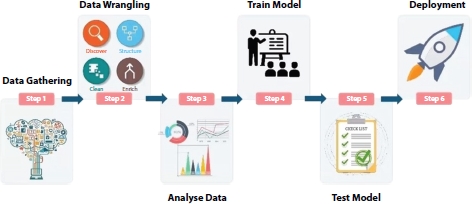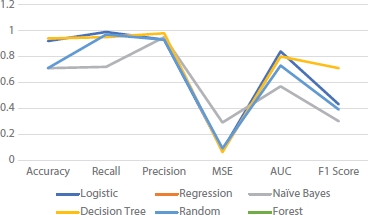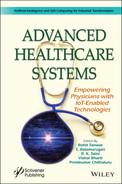3
Study of Thyroid Disease Using Machine Learning
Shanu Verma*, Rashmi Popli and Harish Kumar
J.C. Bose University of Science and Technology, Faridabad, India
Abstract
Thyroid problems occur due to the deficiency of iodine. It is a major health problem among the population living with iodine deficiency, and this endocrine disorder has seen common problems everywhere. Thyroid function test based on the value of TSH, T3 and T4, may indicate thyroid dysfunction and may indicate symptoms and signs that are diagnostic of hyperthyroidism or hypothyroidism. Hyperthyroidism in the gland that contains a high amount of thyroid hormone. Hypothyroidism is a gland that does not fabricate thyroid hormone that perform impaired metabolic functions. Graves is the biggest disease in hypothyroidism which is associated with eye disease. An exceptional type of cancer occurring in the thyroid is a thyroid cancer that infects the gland at the base of the neck. Thyroid cancer disease has been increasing for the past few years. Endocrinologists believe that this is due to the use of new technology, i.e., machine learning, intensive learning allows the detection of thyroid cancer that may not have been detected in the past. According to the Cancer Registry, thyroid cancer is the second more common cancer among women of all cancers, with cancer in thyroid occurring at only 3.5%. This chapter studies thyroid disease using machine learning algorithm.
Keywords: Thyroid, thyroid cancer, hypothyroidism, hyperthyroidism, machine learning, classification algorithm
3.1 Introduction
In India, thyroid disorder is the most common endocrine diseases. About 42 lakh population in India is affected by thyroid disorders. The type of thyroid disorder depends on various characteristics such as sex, iodine levels, age, and more [1]. Hyperthyroidism is one of the primary causes of thyroid cancer, although some researchers suggest that up to 20% of people with hyperthyroidism may be prone to thyroid cancer [15].
Thyroid cancer occurs when the thyroid produces hormones that control your heart rate, blood pressure, weight, and body temperature. It shows no signs or symptoms, and when it grows a lump on the neck that can be felt through the skin, the voice has changed and it has become hoarse. There are various classes of thyroid cancer. Some are growing very gradually and others can be very violent. Globally, thyroid cancer accounts for 32% and the incidence of new cases is 3 lakh per year. In addition, 32,000 thyroid cancer patients die annually.
3.2 Related Works
Over the years, many researchers worldwide worked in machine learning, deep learning, artificial intelligence, predictive analytics, and data science in health-related illness about future challenges and opportunities. Although some research works have been done to determine these possible causes, effects, and solutions, yet it is still a global problem. This chapter will study of thyroid disease using machine learning. Various researchers has studied research work basis for our research and understanding. There are some research papers in this regard are described below.
Parry and Kripke [11] have discussed thyroid effect on women mood disorders. Women have a higher risk of premenstrual, peripartum, and perimenopause that may occur in puberty with oral contraceptive onset and depressive illness. This paper study case reports of various persons and suggest some treatment guidelines such as Treatment-Resistant Unipolar Depression and Rapid Cycling Mood disorders. The conclusion of this paper is that, as compared to men, women have high number of depression.
Razia et al. [20] have studied various machine learning algorithms and comparison between them to achieve better accuracy in the prediction of thyroid disease. The conclusion of this paper is that the decision trees has better accuracy as compared to the naïve Bayes, SVM, and, multi-linear regression.
Pakdel and Ghazavi [12] have described selenium effect on Thyroid disorders. This paper conducts literature survey over the past 20 years’ (1995–2014) papers and discussed that this topic has increased in recent years. This literature paper was restricted to two index such as Social Science Citation Index and Science Citation Index Expanded and performing searching using keyword. The conclusion of this research is that similar studies have to be carried within next 5 years.
Priyanka et al. [1] have studied thyroid disease among women from rural and urban populations in Bangalore. It is described in this letter that every eight women in Bangalore are suffering from thyroid disease. This study was done at the actual hospital in Bangalore.
Godara [17] have predicted thyroid disease using machine learning technique. The method used to detect thyroid disease such as support vector machine and logistic regression on basis of recall, F-measure, error, ROC, and precision. To compare these techniques, Weka version is used.
Mathew [16] have studied thyroid cancer in South India. This study based on population taken from the Registry Program of National Cancer from 2005 to 2014. This paper studies the thyroid cancer patient in Thiruvananthapuram district and compares it with the other four regions Delhi, Mumbai, Bangalore, and Chennai. This paper found that Thiruvananthapuram has a higher rate of thyroid cancer in patients than in the other four regions.
3.3 Thyroid Functioning
Thyroid gland is a predominant organ of human body. Cardiovascular complications include an extreme thyroid condition, increased blood pressure, increased cholesterol levels, depression, and decreased fertility [2]. The thyroid gland has become an important disease in this endocrine region which is an endocrine gland located in the neck, in case of severity the patient may die [3]. There are two traditional diseases of the thyroid that are hyperthyroidism and hypothyroidism that release hormones in the thyroid that control the rate of metabolism of the body. The thyroid glands are made up of two active thyroid hormones that are Triiodothyronine Total (T3) and Thyroxine Total (T4) to control the metabolism of body [4]. From these two thyroid hormones T3 and T4, the main building part of the thyroid glands is iodine which prevails in some problems that are highly potent. To the prediction of disease, machine learning has played a decisive role and provides better accuracy. There are different classification algorithms for prediction whether the patient has thyroid disease or not.

Figure 3.1 Analysis of thyroid.
A machine learning model was trained with a data set of 1,300 benign thyroid nodules and trained with following variables: Name, Age, Triiodothyronine Total (T3), Thyroxine Total (T4), TSH (4th Generation), and Serum [5]. Serum are present in about 60% of patients with autoimmune thyroid disease and are more frequent in females. This research paper has analyzed thyroid disease among different ages in years as shown in Figure 3.1.
3.4 Category of Thyroid Cancer
There are various categories of thyroid cancers that are found in tumours based on cells. These are papillary thyroid cancer, follicular thyroid cancer, anaplastic thyroid cancer, and medullary thyroid cancer, as shown in Figure 3.2.
There are various categories of thyroid cancers.
- • Papillary Thyroid Cancer: Papillary thyroid cancer occurs mostly in children and women and grows very slowly. The common type of thyroid cancer is papillary thyroid cancer. This type of cancer occurs at any stage but is mostly affected between the ages of 30 and 50 [6].
- • Follicular Thyroid Cancer: This is the second most common type of cancer caused by the thyroid and is less common than papillary thyroid cancer. This type of cancer mostly affects people above the age of 50 years. It is also a type of behavioral thyroid cancer but the thyroid has a slightly higher risk of spreading than papillary cancer [6].

Figure 3.2 Categories of thyroid cancer.
- • Anaplastic Thyroid Cancer: Anaplastic thyroid cancer has rapidly developing, poorly differentiated thyroid cancer that can begin with differentiated thyroid cancer or a benign thyroid tumor. It is often seen in patients who have prolonged thyroid inflammation. It spreads rapidly to both local and distant organs [6].
- • Medullary Thyroid Cancer: Medullar thyroid cancer spreads more than other types of cancer. It is a special type of thyroid cancer that is hereditary in many patients. This type of cancer occurs in young children and can be treated well with adequate surgery [6].
3.5 Machine Learning Approach Toward the Detection of Thyroid Cancer
Machine learning is the technology of a new era, and it is the field that is used to construct models and is helpful in prediction of diseases. Machine learning algorithms are used to identify hidden patterns and relationships in historical data. Data are needed to support medical decision-making to predict accurate, robust, and efficient models. The use of machine learning in modern healthcare systems is increasing and necessary [7]. By 2025, CAGR has raised machine learning targets in the healthcare sector from $2.1 billion to $50.2% in 2018 to $36.1 billion. In fact, machine learning has an important part of patient data compared to improving healthcare delivery systems, cutting costs and developing, and monitoring and handling treatment processes and medicines. As we all know that maintaining and updating and recording the patient’s medical history is a very expensive process. These problems are solved by the use of machine learning technologies to reduce time, effort, and money.

Figure 3.3 Machine learning life cycle model.
To build an efficient machine learning project in healthcare, there are various steps to do such as data gathering, data wrangling, analyze data, train the model, test the model, and deployment, as shown in Figure 3.3. Sickness treatment has ordinary influence for healthcare physicians, and impeccable diagnosis at the right time is very important for a patient [2]. Compared to the previous approach, machine learning first builds the model and then presents the first reliable and accurate predictions for model construction without defining patient characteristics.
There are various machine learning algorithms for thyroid detection, some of which are as follows.
3.5.1 Decision Tree Algorithm
This algorithm used the divide-and-conquer method to construct a decision tree to solve the classification problem using decision-making trees [8]. These form a model based on decisions that relate to features in the data set and very fast to train. Examples of these types of models include random forests and conditional decision trees. The goal is to create a model that predicts the accuracy of thyroid disease using target variables, i.e., TSH by using simple decision rules derived from data features, i.e., T3 and T4.
This algorithm works on the basis of input and output variable (x, y) that is specified in a label set of pairs as follows.
The algorithm is to learn the mapping function from the input variable x to the output variable y, which is given the label set of the input output pair
In Equation (3.1), T represents the training set and n represents the number of training samples.
3.5.2 Support Vector Machines
This is machine learning algorithm that is used for text categorization, image segmentation that uses classification algorithm, and regression and detection of outlier. To implement this in healthcare, sampling is divided among training and testing [9]. This algorithm aims to isolate diseases and then work through a hyperplane. This algorithm used the training data as input and separated the graph of the data in the class as output in the hyperplane [10]. Let us consider classification task such as {ui, vi} where i = 1....n ui are data points, ui ϵ Sd and vi are labels. The data points and labels are displaced through the hyperplane with wtx + b = 0, where w represents a D-dimensional coefficient vector that is normal to the hyperplane and b represents an offset from the origin.
3.5.3 Random Forest
This machine learning algorithm is used to estimate hierarchical variables using a classification algorithm and to assess disease risk that evaluates a function that helps doctors to make medical decisions. The training time of random forest is less as compared to other algorithms. In healthcare, this algorithm is used for disease trends and disease risks that can be identified by analyzing the patient medical records.
3.5.4 Logistic Regression
Logistic regression is a supervised learning algorithm that is used to estimate target variables. The nature of the target or dependent variable is dichotomous, meaning that yes or no, there will be only two possible classes. In healthcare, logistic regression is used to predict a patient’s readmitted whether a patient is readmitted to a hospital or not. It can be divided into two classes: either the patient is not admitted or is not readmitted. Logistic regression can be used to classify whether a person will be prone to cancer due to environmental variables such as smoking habit, highway, and drinking alcohol [18].
3.5.5 Naïve Bayes
Naïve Bayes algorithm is used for prediction of disease. This algorithm trains label data sets and for this they must be trained on label data sets. This algorithm works on the basis of prior probability. The prior probability is the probability of disease that is based on its symptoms and is conducted on a data set.
This algorithm is used to predict the disease based on the maximum value between classes and that class will represent its disease or will be selected [19].
ML has contributed a considerable number of disciplines in recent years including healthcare, vision, and natural language processing. There are several machine learning approaches that are analyzed and used for the diagnosis of thyroid disease. The analysis shows that all the papers use different machine learning technologies and show different accuracy. In most research paper, it suggests that logistic regression and decision tree have obtained better accuracy than other algorithms, as shown in Figure 3.4.

Figure 3.4 Analysis of machine learning approach on thyroid.
3.6 Conclusion
The prevalence of thyroid disease in the Earth is still worrisome today, which is seen as a major threat to human life and leading to increased research. Thyroid and thyroid cancers occur mostly in women with a ratio of 3:1 compared to men. Various machine learning approaches have been implemented to predict or detect thyroid disease so that treatment for it is less complex and will increase the patient’s chances of recovery. There is a need to develop machine learning algorithms to analyze the effects of thyroid and thyroid cancer which require the minimum parameters of an individual to detect the thyroid and keeps both the time and money of the patient.
References
1. Priyanka, A prevalence of thyroid dysfunction among young females of urban and rural population in and around Bangalore. Indian J. Appl. Res., 9, 11, 37–38, November – 2019.
2. Chaubey, G., Bisen, D., Arjaria, S., Yadav, V., Thyroid Disease Prediction Using Machine Learning Approaches. Natl. Acad. Sci., 44, 3, 233–238, 2020.
3. Ma, L., Ma, C., Liu, Y., Wang, X., Thyroid Diagnosis from SPECT Images Using Convolutional Neural Network with Optimization. Comput. Intell. Neurosci., Article ID 6212759, 11 pages, https://doi.org/10.1155/2019/6212759, 2019.
4. Yadav, D.C. and Pal, S., Discovery of Hidden Pattern in Thyroid Disease by Machine Learning Algorithms. Indian J. Public Health Res. Dev., 11, 1, 61–66, 2020.
5. Reverter, J.L., Rosas-Allende, I., Puig-Jove, C., Zafon, C., Megia, A., Castells, I., Pizarro, E., Puig-Domingo, M., Luisa Granada, M., Prognostic Significance of Thyroglobulin Antibodies in Differentiated Thyroid Cancer. J. Thyroid Res., Article ID 8312628, 6 pages, https://doi.org/10.1155/2020/8312628, 2020.
6. Thyroid cancer, Patient Care & Health Information Diseases & Conditions, 2020, https://www.mayoclinic.org/diseases-conditions/thyroid-cancer/symptoms-causes/syc-20354161.
7. Beam, A.L., Big Data and Machine Learning in Healthcare, American Medical Association, 2018.
8. Jongboa, O.A., Development of an ensemble approach to chronic kidney disease diagnosis. Sci. Afr., 8, 1–8, 2020, https://doi.org/10.1016/j.sciaf.2020.e00456.
9. Shailaja, K., Machine Learning in Healthcare: A Review. Proceedings of the 2nd International conference on Electronics, Communication and Aerospace Technology (ICECA 2018) IEEE Conference Record #42487, IEEE Xplore.
10. Duggal, P., Prediction Of Thyroid Disorders Using Advanced Machine Learning Techniques. International Conference on Cloud Computing, Data Science & Engineering.
11. Parry, B.L. and Kripke, D.F., Antidepressant and Stabilizing Effects of Thyroid Hormone Augmentation in Women’s Mood Disorders. JETR, 5, 3, 59–67, March 2020.
12. Pakdel, F. and Ghazavi, R., Effect of Selenium on Thyroid Disorders: Scientometric Analysis. Iran J. Public Health, 48, 3, 410–420, Mar 2019.
13. Mathew, I.E. and Mathew, A., Rising Thyroid Cancer Incidence in Southern India: An Epidemic of Overdiagnosis? J. Endocr. Soc., 1, 5, 480–487, 2017.
14. Alhozali, A., Al-Ghamdi, A., Alahmadi, J., Pattern of Thyroid Cancer at King Abdulaziz University Hospital, Jeddah: A 10-Year Retrospective Study. Open J. Endocr. Metab. Dis., 6, 121–125, 2016.
15. Mofit Cancer Center, Cancer Types & Treatments, Can Hyperthyroidism Be a Thyroid Cancer Symptom?, 2018, https://moffitt.org/cancers/thyroid-cancer/faqs/can-hyperthyroidism-be-a-thyroid-cancer-symptom/
16. Mathew, I.E., Rising Thyroid Cancer Incidence in Southern India: An Epidemic of Over diagnosis? J. Endocr. Soc., 1, 5, 480–487, May 2017.
17. Godara, S., Prediction of Thyroid Disease Using Machine Learning Techniques. Int. J. Electron. Eng., 10, 2, 787–793, June 2018, www.csjournals.com.
18. Packt, Healthcare Analytics: Logistic Regression to Reduce Patient Readmissions, 2017, https://hub.packtpub.com/healthcare-analytics-logistic-regression-to-reduce-patient-readmissions/
19. Bohra, H., Health Prediction and Medical Diagnosis using Naive Bayes. Int. J. Adv. Res. Comput. Commun. Eng., 6, 4, 32–35, April 2017.
20. Razia, S., Kumar, P.S., Rao, A.S., Machine learning techniques for thyroid disease diagnosis: A systematic review. Modern Approaches in Machine Learning and Cognitive Science: A Walkthrough, pp. 203–212, 2020.
- *Corresponding author: [email protected]
